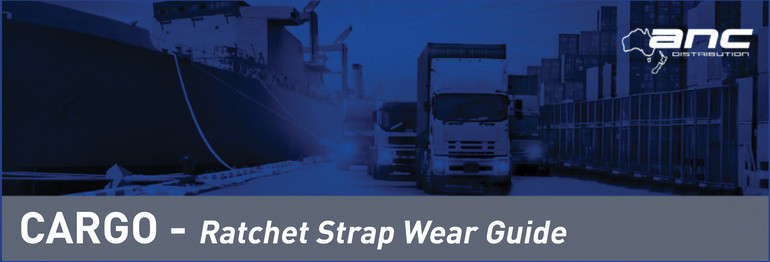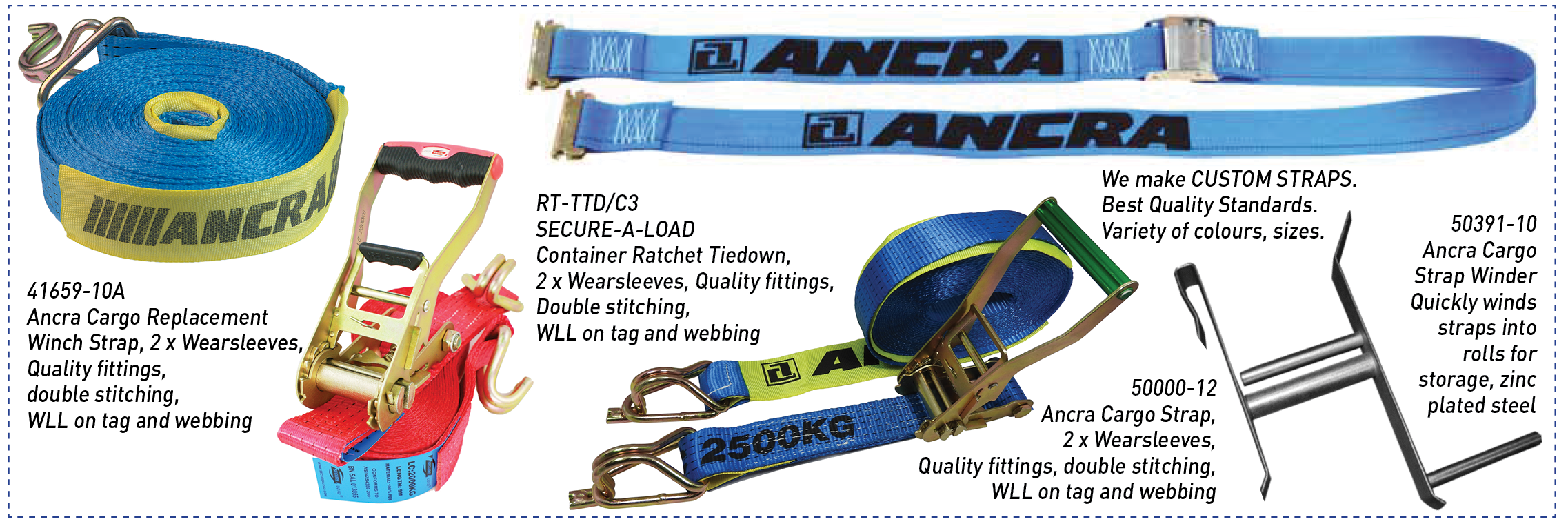Ratchet Straps are the single most used item in Cargo Control today.
Where would we be without them?
So, to allow your Straps to have longevity and to notice the first warning signs of wear and tear,
take a look at this handy guide.

When using webbing, make sure to check for:
Discard the damaged strapping immediately
the strapping must be discarded.
This is an accident waiting to happen as the strapping will not bear the load weight.
Sure Signs of Wear & Tear in your webbing Strap

Certifiers & Designers Checklist
The serviceability and longevity of Strapping is paramount to any Cargo related business or users. There are protocols to follow in relation to
related business or users. There are protocols to follow in relation to
AS4380 standards
.Poor conditions of both webbing and/or attachments
must be guided by these trusty rules and methods:
maximum breaking strength due to:- wear, tear, stitching damage
caused by knotting, bending or excessive loading treatment, corrosion
organic solvents
- Damage due to high temperature exposure
- Exposure over a prolonged period of time to sunlight, ultraviolet light .
This may cause the strapping fibres to become ‘furry’ and indicates
damaged strap fibres.
The straps may no longer be subject to load bearing.
weakened the strapping by 10% or more
Quality Cargo Straps
When you are looking for a top quality strap, there are a number of very important factors to follow.
Firstly, forget about the typical bungees and ropes. Using tiedown straps will offer more security and confidence than any other option. Awkward items such as the kids dirt bikes, lawnmowers, kayaks, bikes and trampolines look to present multiple problems, but your load is safe and secure if using proven quality straps.
The strap itself is made up of either nylon or polyester webbing. Opt in for the polyester type as it can withstand heavy abrasion and has weather-resistant properties which will give longevity to the strap.
For your larger and heavier loads, the webbing comes in widths between 1 and 4 inches
Types of Straps:
Tiedown Straps should always be chosen depending on the cargo you are moving.
Lighter Duty lashing straps: Great for securing surfboards and lighter but cumbersome objects. These straps won’t scratch or damage your items and are easy to use. They are generally bought from any hardware store in packs of two or more.
Heavy Duty Straps: These are perfect for securing general freight of all types. Make sure you check the load rating before you purchase and always choose the strap with more strength than you need. Your heavy duty kinds can be found in a range of different widths, lengths, colours and combinations.
Tiedown straps used for heavier loads should always have proof of compliance with AS/NZS 4380:2001.
The Ratchet - How do I tension my Strap?
The Ratchet mechanism which is threaded onto the strap is the tensioner device. It is so easy to simply lift and press the handle which will gently tighten your strap until your load is firm and secure. With each ratchet click, the strap tightens. It is just as easily loosened by using the handle as a lift-up device. As with all other accessories, the ratchet comes in many variations to suit your size webbing and load bearing requirement.
It even comes as long or short handle, grip or without grip and a reverse option for many uses.
In order for you to decide which ratchet do I use for the capacity of my load, you must consider your strap working capacity. Decide on your Working Load capacity first, the strap you need, then follow with ratchet and end accessories.
ALL webbing straps have a WWL - Working Load Limit and a Break Capacity because if you haul larger loads than what your strap can comfortably handle, you will risk your load, your restraint equipment and possibly endanger others. Do not risk the breaking point of your strap with incorrect WWL in any case. Most straps are around 10 to 20 feet in length. You can also purchase custom made straps for a specific haul requirement.
End Accessories:
You may also want to consider the multiple accessories that can be attached to either one or both ends of the strap. For example, ratchet straps with end hooks can attach to your object solidly and securely. You may even wrap the strap around the object multiple times for further hold strength.
Most straps come with hooks on either end.
However there is a huge range of options that may make your life even easier.

On a heavy-duty tiedown a hook and keeper is used instead of an S-hook or J-Hook. These are an incredibly strong option as not only is it a fully secure device but it allows only ONE person to successfully secure any load. A hook and keeper will NOT come off before tension is applied. The hook firstly needs to be placed under the solid truck or trailer bar. Once in place, the hook is then pushed down or squeezed inward to the keeper in order for the hook and keeper to be fully engaged and secure. The device must be used correctly as a partnership or it will only use 50% of the rated strength tiedown capacity.
A heavier type of cargo such as ride on equipment, motorbikes, kayaks, tool boxes should use the preferred Double J-Hook attachment. This device lies at a 90 degree angle to the plane of the strap. It can therefore provide anchoring points a direct connection to a flat strap surface area. This will not only align your cargo, but the strap will not twist or buckle. J-Hooks can also be supplied as single J-Hooks and swivelling option.
These can be solid bare metal parts or there is an option to have vinyl covering to protect your precious cargo.
The S-Hook end is most typically paired with a ratchet buckle tiedown. They are extremely versatile as they can be used to hook onto car and truck bumper bars, trailer angles, a variety of anchors and D-rings. They may also be used to secure your mountain bikes, dirt bikes, furniture or any heavy and awkward item.
Their sizes vary in width and length, so make sure your s-hook is compatible with your foothold. They are also available in a raw metal or vinyl coating for further goods protection.
If you own a large flatbed trailer, you may prefer the flat hook to secure your heavy or industrial cargo. The flat hook may be used with a winch or ratchet buckle tiedown. The design of the flat hook is square and bent back on itself to allow easy attachment into the side of your flatbed trailer or anchor point. They are generally best for securing huge equipment such as backhoes, excavators, engines, generators and even guardrails and support beams. A flat hook is made from gold passivated material and is also available as raw or vinyl coated.
These nifty devices are also used for the bigger industrial loads that you stress over. They are commonly used with a winch or ratchet buckle tiedown combination on large flatbed trailers. They can be secured into your trailer or any flat anchor points such as a stake pocket. They are most often used for securement of trailers to the tow-hitch of a vehicle, vehicles being towed by a tow-truck and large tents requiring ground stability.
Flat hooks are made from a heat-treated alloy with zinc plating and each unique size has a load bear rating.
So always remember to be SAFE, SECURE and keep an eye on your webbing as it is your most important asset when hauling loads.
ANC Distribution reliable TOP Quality webbing products




